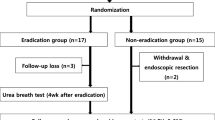Abstract:
The precise etiology of hyperplastic polyps of the stomach is unknown, but recent studies suggest that they arise as a consequence of inflammation occurring in intimate association with Helicobacter pylori infection. The process of polyp regression after anti-H. pylori therapy, however, is unclear. Here we report a patient with large hyperplastic polyps of the stomach that regressed markedly after anti-H. pylori therapy. Histological examination of the regressed polyps revealed a decrease in the height of the hyperplastic foveolar epithelium and a decrease in the amount of inflammatory cell infiltration in the stroma. In addition, the percentage of Ki-67-positive hyperplastic epithelial cells markedly decreased after anti-H. pylori therapy, indicating that the epithelial cell proliferation rate had markedly decreased after treatment. At the same time, the degree of cyclooxygenase-2 expression in epithelial cells in the polyps decreased after treatment. Because cyclooxygenase-2 is expressed at sites of inflammation or neoplasm, these findings are consistent with a decrease in inflammatory cell infiltration, and represent resolving inflammation.
Similar content being viewed by others
Author information
Authors and Affiliations
Additional information
Received: August 11, 1999 / Accepted: October 22, 1999
Rights and permissions
About this article
Cite this article
Nakajima, A., Matsuhashi, N., Yazaki, Y. et al. Details of hyperplastic polyps of the stomach shrinking after anti-Helicobacter pylori therapy. J Gastroenterol 35, 372–375 (2000). https://doi.org/10.1007/s005350050363
Issue Date:
DOI: https://doi.org/10.1007/s005350050363




